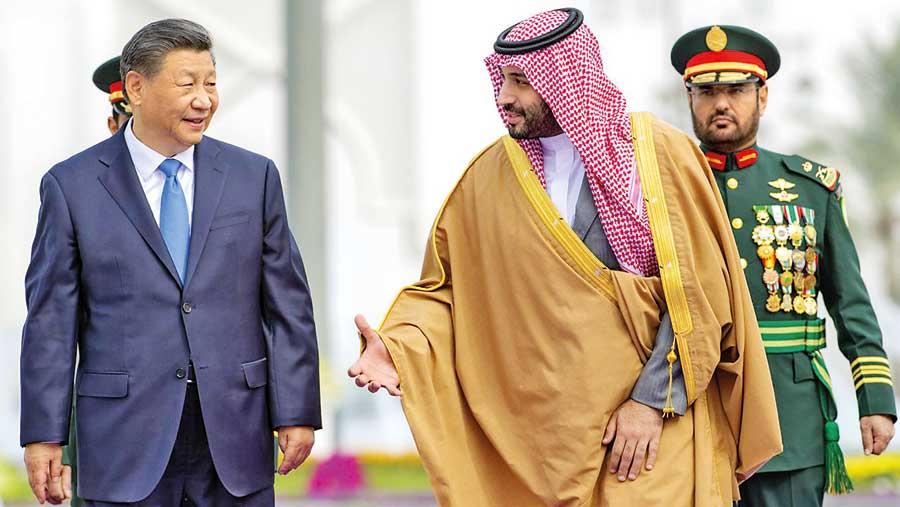Reply To:
Name - Reply Comment

Saudi Crown Prince Mohammed Bin Salman welcomes Chinese President Xi Jinping in Riyadh, Saudi Arabia on December 8. AFP.
It is said that when the United States sneezes, the world catches a cold. This used to be the case. Today it is China that is shaking the world with every move it takes. Early this month, China’s all-powerful President Xi Jinping was in Saudi Arabia. He was given a purple-carpet welcome -- a rare honour.
China’s all-powerful President Xi Jinping was in Saudi Arabia. He was given a purple-carpet welcome -- a rare honour.
The visit indicated a major tectonic shift on the Middle Eastern strategic plateau where the dominant players since the end of World War II had been the United States and its Western allies. Not anymore. China, in well-calculated and highly sophisticated diplomatic moves, is making its presence felt more openly now than it had ever before.
President Xi’s December 8 visit to Saudi Arabia is significant in many ways. He was not only meeting with the Saudi royals. He met top leaders of other Gulf nations and other Arab countries. Among them was Palestinian Authority President Mahmood Abbas. The invitation to Abbas is an indication of China’s readiness to play the honest broker’s role in a newly defined Middle East peace process – the role the US could not play due to its obligations to protect the Zionist state despite its horrendous crimes against Palestinian civilians in occupied territories.
During Xi’s visit, the agreements signed and the statements made were loaded with the political meaning that China has mustered enough mettle to play an equally dominant role in international political and economic affairs, just as the US.
The visit shines a light on the present trajectory of international politics – and also that of the coming year. As the Athenian historian Thucydides theorised millennia ago, the dominant power would not just give up its top position to the power that is closely pursuing it. The end game is a confrontation. International relations experts call this the Thucydides trap.
But sans a confrontation, China seeks to edge out the US.
Signs of such intention have been evident since the sleeping giant – that was how Napoleon described China – woke up from its slumber in the last decade of the last century and transformed a poverty-stricken nation into the world’s second economic power which it is today.
Through Xi’s visit, is China trying to eject the US from the Middle East, as the proverbial camel did to the Arab resting inside a tent? Yes, it appears to be so and is happening at China’s own pace.
Xi’s visit carried multiple objectives aimed at deepening China-West Asia ties through defence and economic cooperation. Like China, Saudi Arabia has been, in recent years, discreetly enhancing its China ties.
Till 1990, the two countries did not have diplomatic ties. Saudi Arabia, then the citadel of the Wahhabi strain of Islam, had embraced the capitalist West in opposition to what it termed the ‘Godless communism” of the Soviet Union and China. With its blind faith in the US-led West, the then Saudi rulers failed to see that Godless communism with an ideology of serving humanity in a spirit of give-and-take based on a person’s need was certainly better than greed-driven capitalism which would sell even God for a profit.
Today, under the Vision 2030 programme of Crown Prince and Prime Minister Muhammad Bin Salman (MBS), Saudi Arabia is drifting away from hardline Wahhabi Islam which it exported to other parts of the world not to promote Islam’s cause but to help the West achieve its strategic objectives.
Saudi Arabia is also quietly slipping away from the US grip, which had its origin in the historic meeting between US President Franklin D. Roosevelt and Saudi Arabia’s founder monarch Abdul Aziz Ibn Saud onboard the USS Quincy in the Suez Canal in 1945. This was evident in Saudi Arabia’s recent snub to the US when US President Joe Biden visited Saudi Arabia in July. Biden urged the Saudis to increase the oil output and bring down the prices that shot up after Russia’s invasion of Ukraine in February this year. But immediately after the visit marked by the now famous Biden-MBS fist bump, the Saudis did the opposite. They reduced production, denying Biden the advantage he was seeking to prop up his Democratic Party’s prospects at the November mid-term elections. And now the high-profile Xi visit and Saudis getting too friendly with him.
Saudi Arabia has also been supporting China over allegations that Beijing was oppressing its Uighur Muslim population in the Xinjiang province, much to the chagrin of the US-led West which is trying to make it an international human rights issue.
During a series of meeting President Xi had in the Saudi capital, Riyadh, China took an important move in converting its national currency into an international petroyuan – like the petrodollar, which is used for more than 80 percent of the global energy transactions – for oil deals between China and the Gulf nations. Already, Russia, Iran, India, China and a few Central Asian nations have agreed to conduct transactions with each other in their own currencies as much as possible – a move, if continued and further established, will weaken the power of the dollar as an international currency.
Xi’s visit, the fifth by a Chinese leader to the kingdom since diplomatic ties began in 1990, signals the dawn of the petroyuan era. After signing deals worth US$ 30 billion – a pittance when compared to the US$ 450 billion package the Saudis pledged to the US during President Donald Trump during his stay over in Riyadh -- Xi told his Arab hosts that China would use the yuan for oil trade through the Shanghai Petroleum and National Gas Exchange. He urged the Gulf nations to get on board – an offer they found difficult to reject. China is the world’s number one oil importer. Some 18 percent of Saudi Arabia’s oil exports are bought by China, its biggest buyer. About half of China’s oil needs comes from the Gulf region, including Iran. It also buys oil from Russia, Angola, and a host of other nations. Xi told the Gulf leaders that China would import crude oil in a consistent manner and in large quantities from the Gulf region.
With Saudi Arabia endorsing China’s Belt-and-Road Initiative and showing a keen interest in joining the BRICS, an economic bloc comprising Brazil, Russia, India, China, and South Africa, China’s clout in the Saudi-led Gulf region is increasing. Saudi Arabia’s interest in BRICS and even the Shanghai Cooperation Council is perhaps also aimed at neutralizing Iran, the Saudi’s enemy next door which is improving its strategic cooperation with China and Russia and a regional force to be reckoned with today.
China’s Middle Eastern diplomatic surge comes as the US influence is waning in the region after it reached a crescendo during the Trump presidency, with Arab nation after Arab nation listening to the US dictates and signing Abrahamic accords with Israel. China’s foray into the Middle East also comes at a time when the US is strained by the military burden of the Ukraine war and the need to fortify its military presence in Asia in anticipation of a Chinese military shock over Taiwan.
What will the Biden administration do to dampen China’s Middle Eastern diplomatic victory? This is the question that bothers most Middle East watchers now.